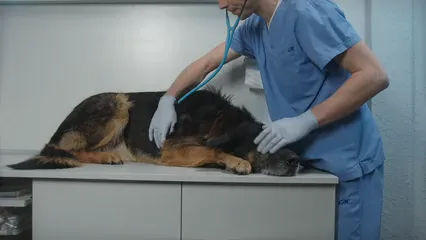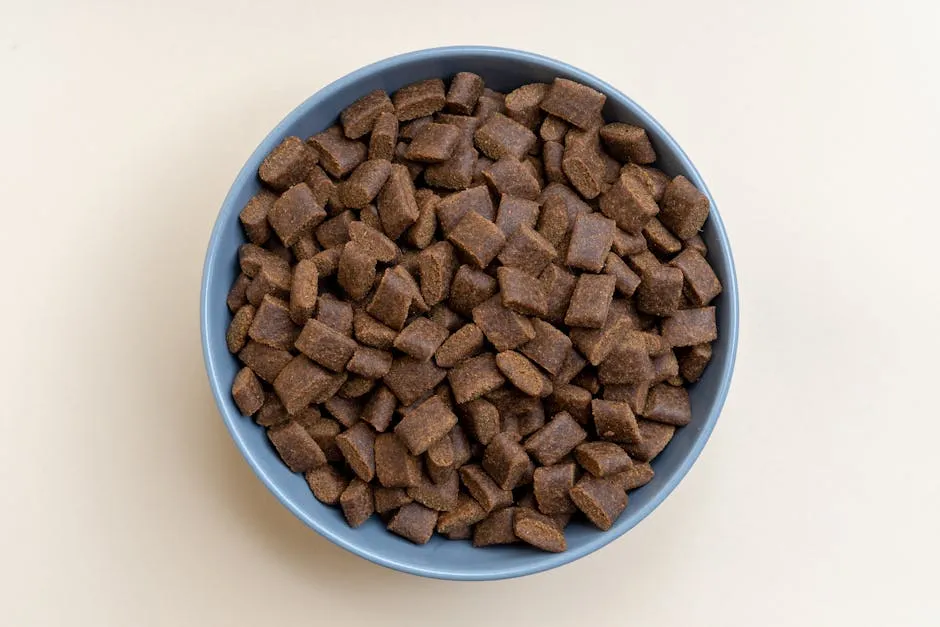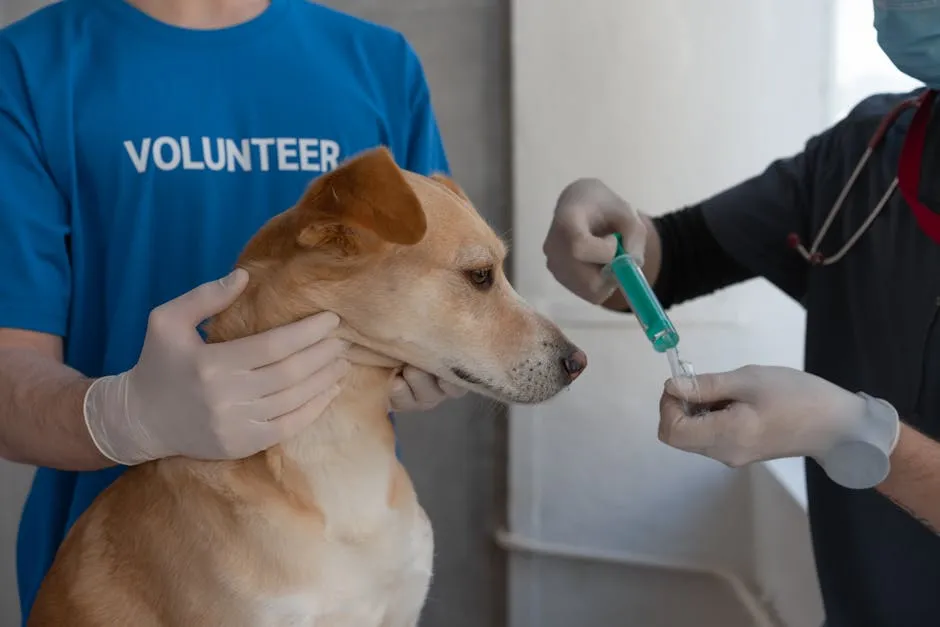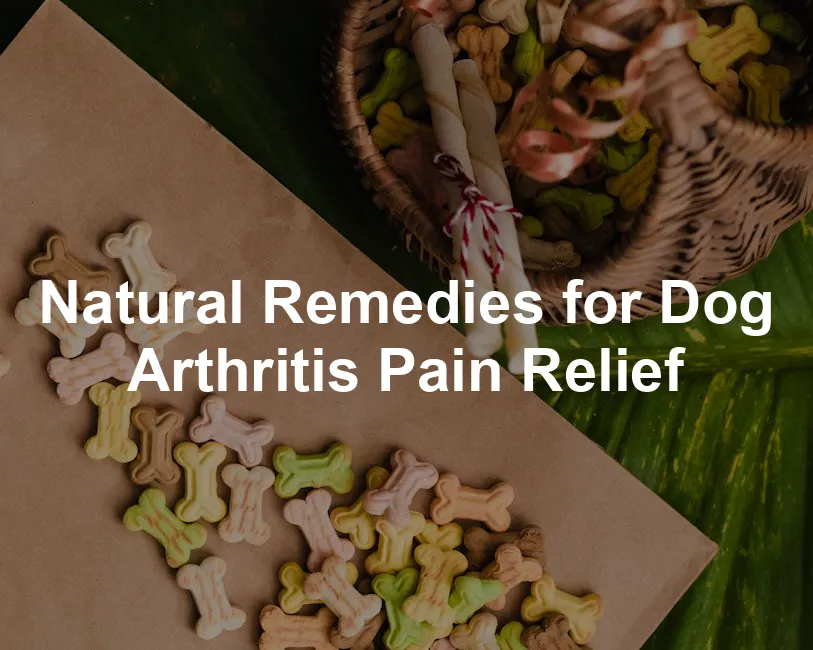Introduction
Arthritis in dogs is like that old sock stuck in the dryer—annoying, persistent, and often ignored until it’s too late. This condition is especially common in older dogs and larger breeds, where the wear and tear on joints can become a daily struggle. If your furry friend has started moving slower or seems reluctant to join in on playtime, it might be time to consider the possibility of arthritis.
Recognizing the symptoms is crucial. Signs like limping, stiffness, or changes in behavior can all indicate joint issues. Catching arthritis early means you can take action sooner to help alleviate your dog’s discomfort. In this article, we’ll explore natural remedies that might just save the day—or at least make it a bit more comfortable for your four-legged buddy. Get ready to discover ways to manage arthritis pain naturally, so your dog can wag their tail with joy again!

Understanding Dog Arthritis
What is Dog Arthritis?
Arthritis is the inflammation of the joints, and it’s a real pain in the… well, joints! The most common type is osteoarthritis, which occurs when the protective cartilage cushioning the joints wears away. This degeneration leads to painful bone-on-bone contact, making movement stiff and challenging. Your pup might struggle to jump onto the couch or get up after a nap, and who can blame them? That doesn’t sound fun at all!
Causes of Dog Arthritis
Several factors contribute to the development of arthritis in dogs. Age is a significant player; as dogs grow older, their joints naturally weaken. Genetics also plays a role; some breeds are just more prone to joint issues than others. Injuries from past accidents can haunt them, leading to uneven wear on the joints. And let’s not forget about obesity! Extra pounds mean extra pressure on those joints, which can accelerate the arthritis process. Lastly, a dog’s activity level matters. Too much high-impact activity can lead to joint problems down the line.
Symptoms of Dog Arthritis
So, how can you tell if your dog is suffering from arthritis? Keep an eye out for these common signs:
- Limping or difficulty walking
- Stiffness, especially after resting
- Reluctance to move or play
- Changes in behavior, like increased irritability
- Trouble getting up or lying down comfortably
Early detection is essential! If you notice any of these signs, don’t hesitate to consult your veterinarian. They can help determine the best course of action for your beloved pet. Remember, the sooner you act, the better the chances of keeping your furry friend happy and active.

Natural Remedies for Dog Arthritis Pain Relief
Maintaining a Healthy Weight
Keeping your dog at a healthy weight is essential! Why? Because extra pounds mean extra pressure on those poor joints. Just like us humans, dogs can experience joint stress when they’re carrying a bit too much baggage. This added stress can worsen arthritis symptoms, leading to discomfort and decreased mobility.
To help your pup shed those pesky pounds, start by consulting your veterinarian. They can create a tailored weight-loss plan just for your furry friend. Regular weigh-ins at the vet can help track progress. Next, consider adjusting their diet. Look for high-quality dog food specifically designed for weight management. These foods are often lower in calories but still packed with essential nutrients.
Portion control is crucial! Measure out your dog’s food instead of free-feeding, which can lead to overeating. And let’s not forget about treats. Opt for low-calorie snacks and keep them to a minimum. You can even use veggies like carrots or green beans as tasty, guilt-free rewards.
Exercise is another key component in weight management. Aim for daily walks or play sessions with your dog. Short, frequent walks are better than one long trek, as they help to keep your dog’s joints limber without overexerting them. Remember, every little bit counts! You’ll help your pup feel lighter and more comfortable, while also improving their overall health.
Consider adding a PetFusion Orthopedic Dog Bed to your home. It provides the support your arthritic pup needs for a good night’s sleep, making those morning walks a bit easier!

Diet and Nutrition
Anti-inflammatory Diet
Diet plays a significant role in managing arthritis pain. An anti-inflammatory diet can work wonders for your dog’s joints. Include foods rich in omega-3 fatty acids, like salmon or fish oil. These healthy fats can help reduce inflammation and promote joint health. Antioxidants, found in blueberries and spinach, are also great additions. They combat oxidative stress, which can exacerbate inflammation.
On the flip side, there are some foods you should avoid. Grains and fillers can lead to inflammation, making arthritis symptoms worse. Nightshade vegetables, like tomatoes, potatoes, and eggplants, may also trigger pain in some dogs. Instead, focus on whole foods—think sweet potatoes, quinoa, and leafy greens. Your dog will thank you!
Joint Supplements
In addition to a proper diet, consider joint supplements. These can provide your pup with extra support for their aching joints. Glucosamine is a popular choice. It helps rebuild cartilage and can alleviate pain. Chondroitin works alongside glucosamine to enhance joint function. Many dog owners report significant improvements after adding these supplements to their dog’s routine.
Omega-3 fatty acids, found in fish oil, can also be beneficial. They reduce inflammation and promote overall joint health. Just remember to consult your veterinarian for the right dosages tailored to your dog’s specific needs. Consider adding Zesty Paws Glucosamine for Dogs to your dog’s diet for added joint support!
Turmeric is another natural remedy worth mentioning. This golden spice is packed with curcumin, which has powerful anti-inflammatory properties. A daily dosage of about 0.5 to 1 teaspoon can be effective. Mix it into their food, and watch them strut their stuff with less discomfort!

Exercise and Physical Activity
Regular, low-impact exercise is a game changer for dogs with arthritis. It helps maintain muscle mass and joint flexibility while keeping those pesky pounds at bay. Think of it as a gentle tune-up for your pup’s joints!
Walking is a fantastic option. Aim for shorter walks multiple times a day instead of one long trek. This way, your dog can enjoy the outdoors without overdoing it. Swimming is another excellent activity. It’s easy on the joints and provides a full-body workout. Just make sure your dog feels comfortable in the water! Consider investing in a Paws Aboard Doggy Life Jacket to help your pup stay safe while swimming!
You can also engage in fun games like fetch, but keep it light. Avoid high-impact activities like jumping or running on hard surfaces, as these can lead to further joint strain. Always pay attention to your dog’s cues. If they seem tired or in pain, it’s time for a break.
Consider incorporating stretching or gentle massage into your routine. These can improve circulation and flexibility. If your dog enjoys a good belly rub, why not turn it into a mini massage session? It’s a win-win!
In summary, maintaining a healthy weight, providing a balanced anti-inflammatory diet, and ensuring regular, low-impact exercise can significantly improve your dog’s quality of life. By following these natural remedies, you’ll help your furry companion manage arthritis pain more effectively. So, let’s get moving and keep those tails wagging!

Home Modifications for Comfort
Creating a dog-friendly environment is essential for your furry friend dealing with arthritis. A few thoughtful modifications can make a world of difference. Start with orthopedic beds. These beds provide extra support for aching joints, ensuring your pooch sleeps soundly. Look for memory foam options that contour to their body. Your dog will appreciate the cozy, cushioned haven! Check out the FurHaven Plush & Suede Orthopedic Dog Bed for a perfect night’s sleep!
Next up, ramps instead of stairs. Stairs can be a daunting obstacle for arthritic dogs. They may hesitate or struggle to climb them, leading to frustration. A sturdy ramp allows your pup to access their favorite spots without straining. Place ramps at the entrance of your home or by the bed to make life easier. Consider the PetSafe Happy Ride Dog Ramp for easy access to your vehicle!
Don’t overlook non-slip surfaces! Slippery floors can turn your home into a mini ice rink, especially for dogs with joint pain. Invest in non-slip rugs or mats in high-traffic areas. These provide better traction and help prevent falls. You can also consider traction socks designed specifically for dogs. They offer stability and keep your pup moving safely. Check out PetSafe Non-Slip Dog Socks for added grip!
By making these simple changes, you can significantly enhance your dog’s comfort at home. A cozy bed, easy access, and secure footing will help them navigate their space with ease, keeping tails wagging and spirits high!

Alternative Therapies
When it comes to easing arthritis pain, alternative therapies can be a game changer. Acupuncture, for example, has gained popularity among pet owners. This ancient practice involves inserting tiny needles into specific points on your dog’s body. It can help relieve pain and promote healing by stimulating nerve function and blood flow.
Physical therapy is another fantastic option. A certified canine physical therapist can tailor exercises to your dog’s needs. These sessions can strengthen muscles, improve flexibility, and reduce stiffness. Regular therapy helps keep your dog’s joints healthy and functioning optimally.
Hydrotherapy is a splashing good time! Swimming in warm water reduces joint stress while providing a full-body workout. Many facilities offer underwater treadmills, which allow your dog to exercise without the impact. This gentle approach keeps them active and happy.
Lastly, let’s chat about CBD oil. Many pet owners are turning to this natural remedy for pain relief. CBD has anti-inflammatory properties and may help reduce anxiety. However, dosage is crucial. Generally, you can start with 2-8 mg per kg of body weight. Always consult your vet before starting any new treatment. For a calming effect, consider Vet’s Best Comfort Calm Soft Chews!
Incorporating these alternative therapies into your dog’s routine can offer significant relief. Each option provides a unique way to support your furry friend’s journey toward comfort and mobility.

Veterinary Treatments and When to Consult a Vet
Veterinary treatments play a critical role in managing arthritis in dogs. Non-steroidal anti-inflammatory drugs (NSAIDs) are often the first line of defense. These medications reduce inflammation and alleviate pain, allowing your dog to move more comfortably. However, they can have side effects, so monitoring your dog closely is essential.
Corticosteroids are another option. These powerful anti-inflammatories can provide quick relief during flare-ups. Your vet will guide you on the proper usage and dosage to minimize risks. In some cases, your veterinarian may suggest joint injections to directly target inflamed areas. These treatments can offer significant relief and improve your dog’s quality of life.
But how do you know when it’s time to consult a vet? Keep an eye out for signs of increased pain or discomfort. If your dog struggles to get up, shows reluctance to engage in activities they once loved, or exhibits behavioral changes, it’s time to seek professional help. Sudden weight gain or loss can also indicate underlying issues that need addressing.
Regular veterinary check-ups are crucial. These visits allow your vet to monitor your dog’s condition and adjust treatments as needed. Early intervention can make a significant difference in managing arthritis. Remember, your vet is your best ally in keeping your dog happy and comfortable. Together, you can create a tailored plan that addresses your furry friend’s unique needs.

Conclusion
In summary, managing arthritis in dogs is no walk in the park, but it doesn’t have to be a total flop either! We’ve covered crucial natural remedies that can help your furry friend find relief from joint pain. Maintaining a healthy weight is essential for reducing stress on their joints. An anti-inflammatory diet filled with omega-3 fatty acids and antioxidants can work wonders. Regular low-impact exercise keeps those joints moving and happy!
Don’t forget the power of home modifications! Soft orthopedic beds, ramps, and non-slip surfaces can make a world of difference. And let’s not overlook alternative therapies like acupuncture and CBD oil, which can provide additional relief. For dental health, consider Arm & Hammer Dog Dental Chews to keep those pearly whites clean!
As you explore these natural remedies, remember to always keep your veterinarian in the loop. They are your best ally in determining the right combination of treatments for your dog’s unique needs. A holistic approach, combining veterinary guidance with natural solutions, is key to helping your dog live a comfortable and fulfilling life despite arthritis. So, let’s roll up our sleeves, take action, and help those tails wag again!

FAQs
What are the best natural supplements for dog arthritis?
When considering natural supplements, glucosamine and chondroitin are top contenders. They help rebuild cartilage and relieve joint pain. Omega-3 fatty acids, found in fish oil, are also fantastic for reducing inflammation. Turmeric is another powerhouse; its active compound, curcumin, offers strong anti-inflammatory benefits. Always consult your vet for the right dosages tailored to your dog.
Can diet really help with my dog’s arthritis?
Absolutely! The right diet can significantly impact your dog’s joint health. An anti-inflammatory diet, rich in omega-3 fatty acids, antioxidants, and whole grains, can help reduce inflammation. Foods like sweet potatoes, blueberries, and leafy greens are great choices. Avoid grains and nightshade vegetables; they can exacerbate inflammation. Always discuss dietary changes with your vet to ensure they’re suitable for your dog.
How can I tell if my dog is in pain from arthritis?
Signs of arthritis pain in dogs can be subtle. Watch for limping, reluctance to move or jump, and stiffness after resting. You might notice changes in behavior, such as increased irritability or withdrawal from activities they once loved. If your pup seems to have difficulty getting up or prefers to stay in one spot, these could be indicators of worsening pain. Consult your veterinarian for a proper assessment if you observe these signs.
Are there specific exercises that are better for arthritic dogs?
Yes! Low-impact exercises are best for dogs with arthritis. Short, gentle walks are excellent, as they promote mobility without overexertion. Swimming is a fantastic option too; it’s easy on the joints and provides a full-body workout. Consider games like fetch, but keep them light and avoid high-impact activities. Always monitor your dog during exercise and adjust based on their comfort level.
Is it safe to use CBD oil for my dog?
CBD oil can be a safe option for managing arthritis pain in dogs. Many pet owners report improvements in pain and mobility. It’s believed to have anti-inflammatory properties and can also help reduce anxiety. However, dosage is crucial—start low and go slow, typically around 2-8 mg per kg of body weight. Always consult your veterinarian before introducing CBD oil to ensure it’s suitable and safe for your furry friend.
Please let us know what you think about our content by leaving a comment down below!
Thank you for reading till here 🙂
If you’re looking for natural remedies for dog anxiety during thunderstorms, it can also help with your dog’s overall well-being.
All images from Pexels





